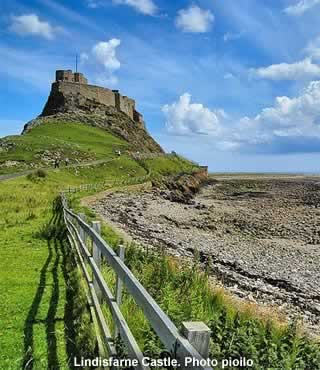Lindisfarne |
|
 |
|||
A tidal island just off the coast of Northumberland with strong links to Christianity |
||
Lindisfarne, just off the coast of Northumbria, is a tidal island. This means that during high tide, the causeway which links it to the mainland is completely covered by seawater. It's worth stressing this fact, as every year some people lose track of time, and end up having a much longer stay than they'd planned! Even worse, some unlucky travellers find themselves on the causeway at precisely the wrong time, and have to be rescued by the coastguard from the rising water. |
||
There aren't many places where just getting there requires this much planning and timing, but Lindisfarne is an island with lots of sights and an interesting history, so making the trip is definitely worth your while. |
||
The island has strong links with Christianity. During the Anglo-Saxon times, it was considered to be one of the holiest places in the country, which led to it being nicknamed Holy Island. The first Christian to come here arrived in the year 635 AD. He was an Irish monk named St. Aidan, and he set up a monastery called Lindisfarne Priory. Not long afterwards, this new establishment was taken over by the most famous bishop of its history. This was St. Cuthbert, an evangelist and reputed miracle worker who became well known in northern Britain. He was in charge for two years before leaving for the nearby Farne Islands, where he could find solitude. |
||
Today, the building lies in ruins. But there are still some walls standing, as well as a few of the old stone arches, which give an idea as to how elegant the Priory might have been in its heyday. A visitor centre retells the story of the monks who came here, and gives some insight into why the island became an important destination for Christian pilgrimages. In fact, the place still receives pilgrim visitors to this day. You're free to wander around the ruins as you like; it actually makes for a popular picnic spot. |
||
The Priory is also known for its biggest treasure: the Lindisfarne Gospels that were produced here in the late 7th Century. These are a collection of illustrated, handwritten Latin copies of the first 4 books of the Bibles New Testament. They're now kept in the British Library, in London, but a digital copy can be viewed at the Lindisfarne Heritage Centre. This museum also takes a good look at the rest of the island's history, from its nautical heritage, to its natural beauty. |
||
Part of this history involves another major landmark, Lindisfarne Castle. When Henry VIII ordered that all of England's monasteries be torn down, much of the stone that was used in the Priory was reclaimed to construct this new fortress. Since that time, the building has been transformed into a stately home, in an Edwardian style. The castle sits on its own little outcrop of rock, which is connected to Lindisfarne by a small causeway, in much the same way as Lindisfarne itself is connected to the mainland. |
||
The fort used to have a nearby vegetable garden, but by the early 20th century, this was long out of use. It was transformed into a walled garden, which offers a spot of cheery colour in the shadow of the stern-looking castle. |
||
Even without sights like this, Lindisfarne would still be worth a visit. Much of it is part of a protected nature reserve, which features flocks of seabirds, crowds of seals, and carpets of flowers. Some people even come just for the local drink, an alcoholic honey-based liquid called meade. This tasty concoction is the origin of the phrase "honeymoon". Nordic newly-weds would drink it exclusively for an entire month, which was said to increase their fertility! Meade is said to be the first alcoholic drink to ever be made, on the entire globe, and it was apparently favoured by such mythical figures as Beowulf, and King Arthur. |
||
|
||
Lindisfarne Castle is open daily from March to October from 10am to 3pm (times may vary). Entry costs around £7 for adults, £3.50 for children. Holy Island, Berwick-upon-Tweed, Northumberland, TD15 2SH. Tel: 01289 389 244 |
||
|
Pocket Britain is optimised for use on a smartphone or tablet with internet access. All content is subject to copyright. All reasonable methods have been used to ensure information supplied is accurate at the time of publication. However, it is advisable to check information before relying on it. Privacy Policy |